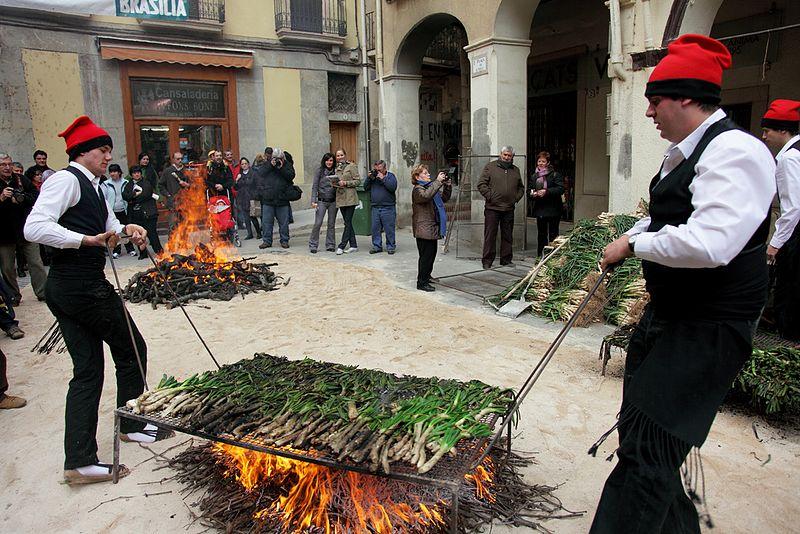[Get to know MEDUSA's territories] Calçotada, a curious Catalan culinary tradition

This article forms part of a series of publications under MEDUSA project to promote less-known natural and cultural touristic assets in our partner territories Jordan, Lebanon, Tunisia, Puglia (Italy) and Catalonia (Spain). Enjoy reading and hope to welcome you soon at one of the wonderful places you will get to know here.
A curious Catalan Culinary Tradition - Calçotada
If you have ever been to Catalonia in springtime, you might have seen a long leek/spring onion sort of produce being sold on fruit markets and announces on restaurant menus. This hybrid vegetable (not a spring onion nor a leek) in Catalan is called Calçot and is probably one of the most unique and authentic products from the north-eastern Spanish region. It is said that it was first cultivated by a peasant from the town of Valls in the south of Catalonia near Tarragona. Apparently, the man had a whim for grilled onions but had difficulties to get them soft inside since the bulb of onions is usually big and round.
.jpg) To avoid this, he invented a new way of growing them, covering the sprout of the onion with soil as it gets bigger to maintain its white colour and tenderness. That way, a long but think spring onion perfectly suitable for grilling turned out. By today, Calçots have become very popular and known even outside of Catalonia and what is more, have been recognized with a Protected Geographical Indication (PGI).The season of this particular vegetable theoretically ranges from November to April whereas it is mostly consumed from January to March. This is when Catalans come together with family and friends to celebrate the so-called Calçotadas – get-togethers with the sole purpose of consuming grilled Calçots. In its town of origin, Valls, and in many other places all over Catalonia every year, municipalities, city district associations or rural restaurants organise popular Calçotadas, where people gather around fireplaces and long tables and benches to enjoy the onion meal. Those public events are open to everyone and are surely the most authentic occasion to try them. You can however also get them in restaurants all over the place.The eating of the vegetable is a ritual in itself. First, the onions are grilled on open fire until their outermost layers are totally charred. Around a dozen of them per person are then traditionally served on a roof tile. To eat them, it is advisable to wear old cloth and prepare for getting your hands dirty. Otherwise, you can make use of a bib and gloves that usually come with the dish in restaurants.
To avoid this, he invented a new way of growing them, covering the sprout of the onion with soil as it gets bigger to maintain its white colour and tenderness. That way, a long but think spring onion perfectly suitable for grilling turned out. By today, Calçots have become very popular and known even outside of Catalonia and what is more, have been recognized with a Protected Geographical Indication (PGI).The season of this particular vegetable theoretically ranges from November to April whereas it is mostly consumed from January to March. This is when Catalans come together with family and friends to celebrate the so-called Calçotadas – get-togethers with the sole purpose of consuming grilled Calçots. In its town of origin, Valls, and in many other places all over Catalonia every year, municipalities, city district associations or rural restaurants organise popular Calçotadas, where people gather around fireplaces and long tables and benches to enjoy the onion meal. Those public events are open to everyone and are surely the most authentic occasion to try them. You can however also get them in restaurants all over the place.The eating of the vegetable is a ritual in itself. First, the onions are grilled on open fire until their outermost layers are totally charred. Around a dozen of them per person are then traditionally served on a roof tile. To eat them, it is advisable to wear old cloth and prepare for getting your hands dirty. Otherwise, you can make use of a bib and gloves that usually come with the dish in restaurants.
.jpg)
Peeling them in one swipe takes some practice but after some tries you surely get the hang of it. Here goes a guide for beginners: Hold the onion with one hand on the top (green part) place thumb and index finger of the other hand right below and form a ring around the onion, with some slightly pressure pull the burnt layers off towards the lower end of the onion. What should appear is the perfectly white and tenderly clocked inner part of the onion. You now dib the onion into delicious Romesco souce made from toasted almonds, tomatoes, olive oil and garlic, put your head back and the onion in your mouth from above. You will be surprised about how many onions a single person is able to eat at once. Cutlery is obviously forbidden in this whole process.If you want to complete the meal, have a Butifarra – a typical Catalan farmer sausage – and white beans (Mongetes) with it. And, something that can never be missing in any Catalan plate, accompany it with Pa amb Tomàquet (bread with tomato). But that is a whole other story about Catalan cuisine…









